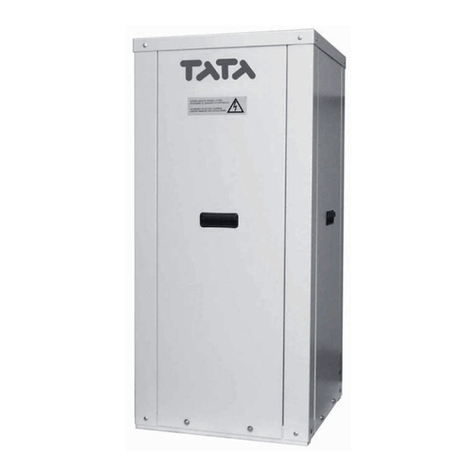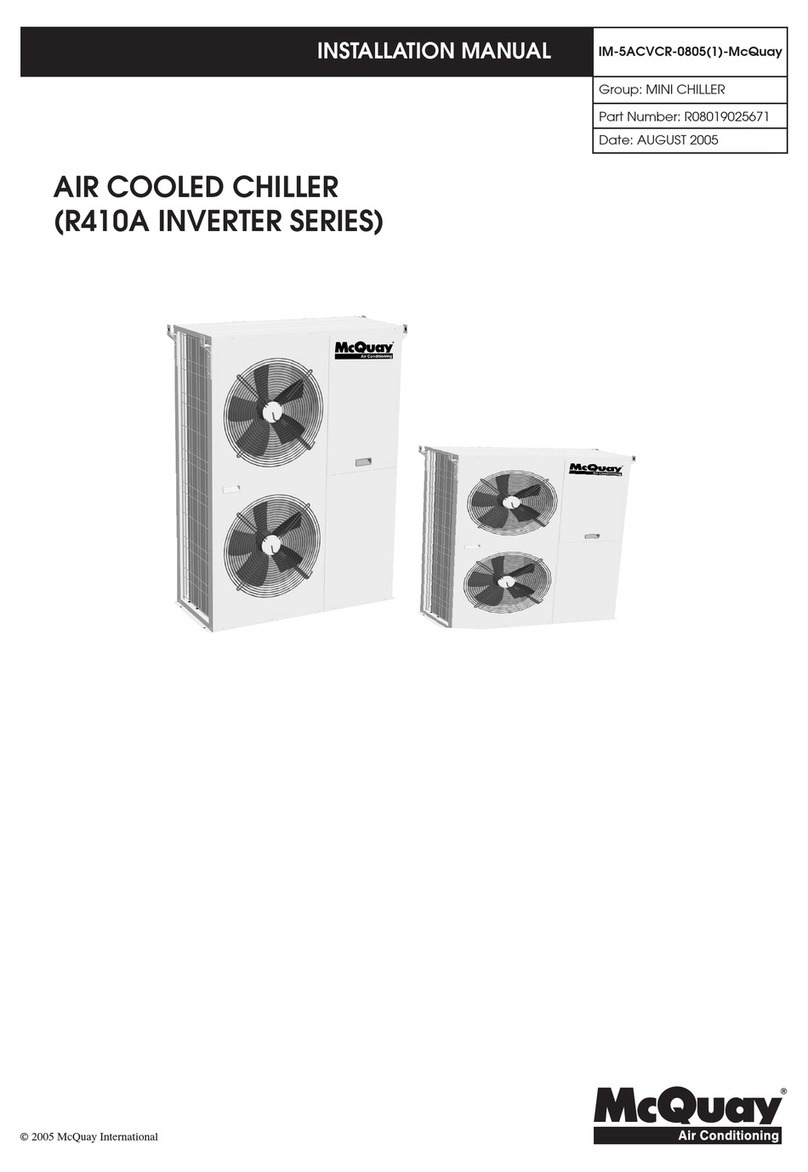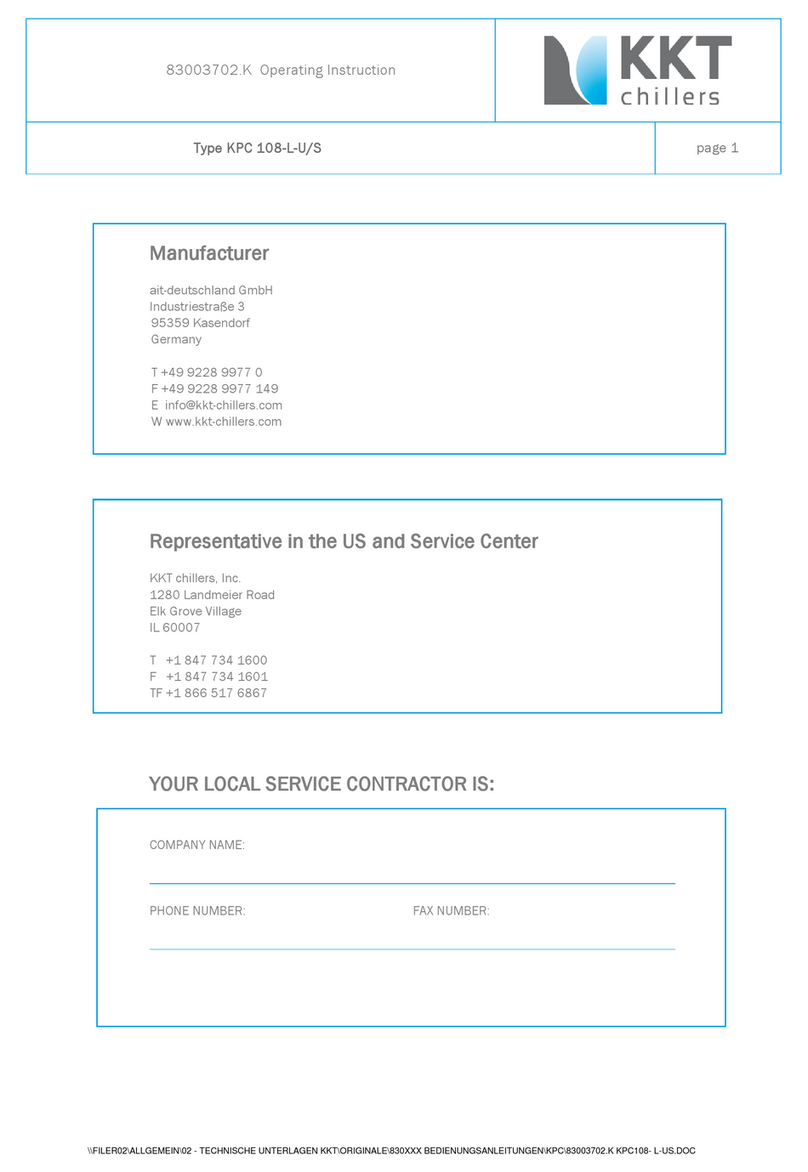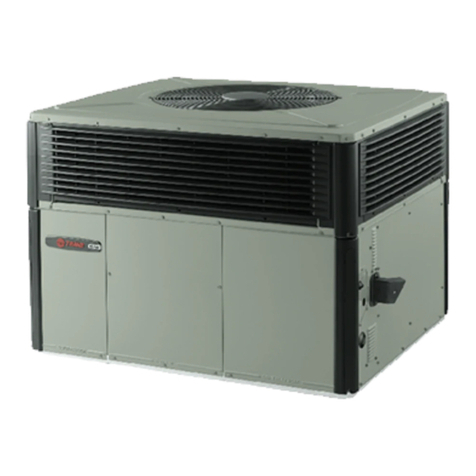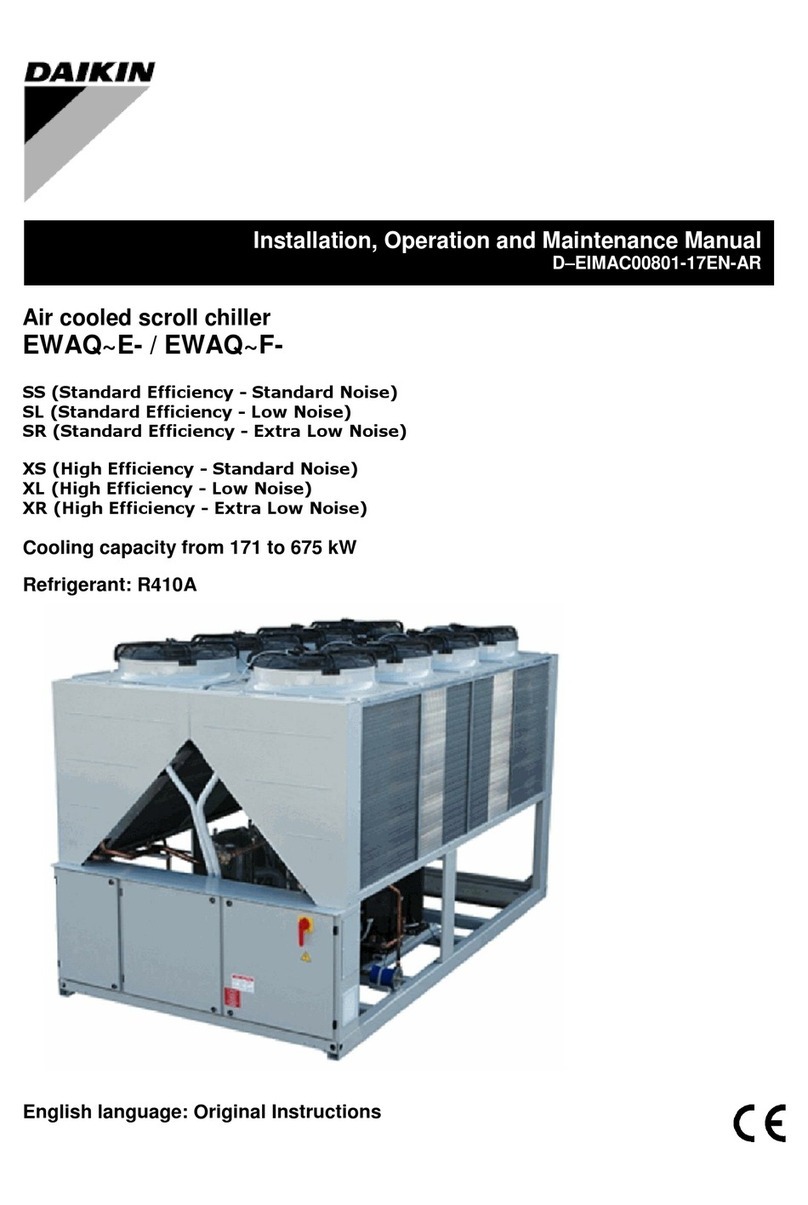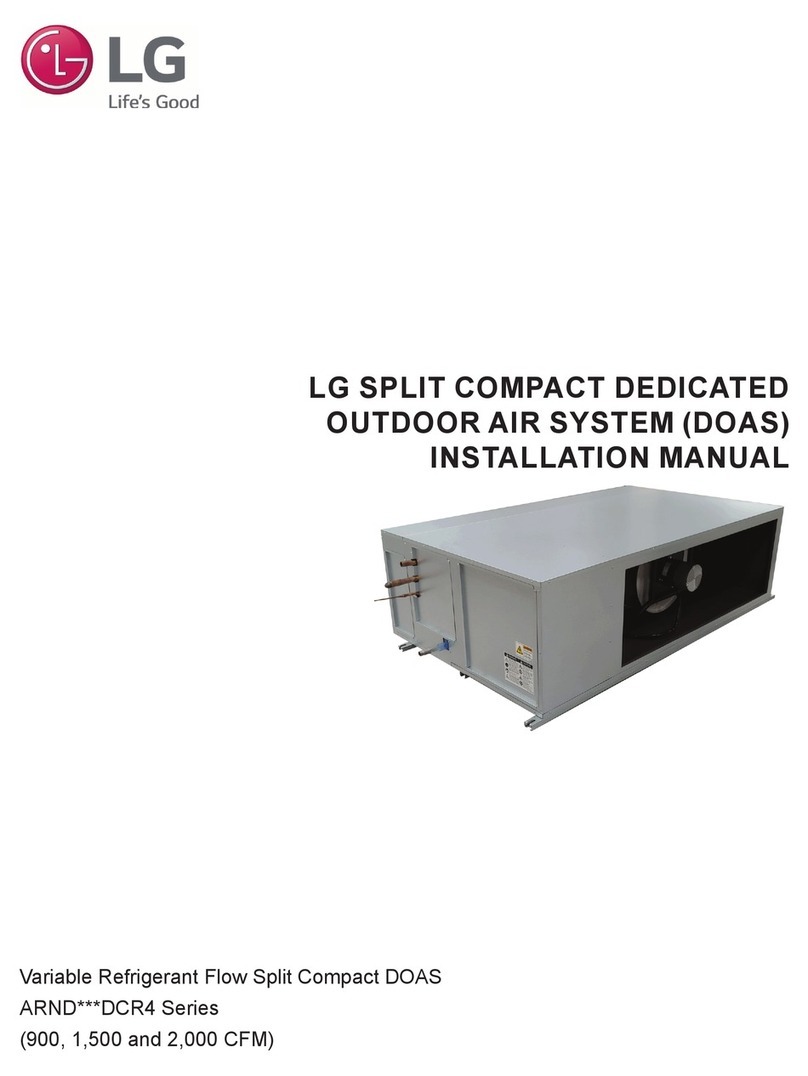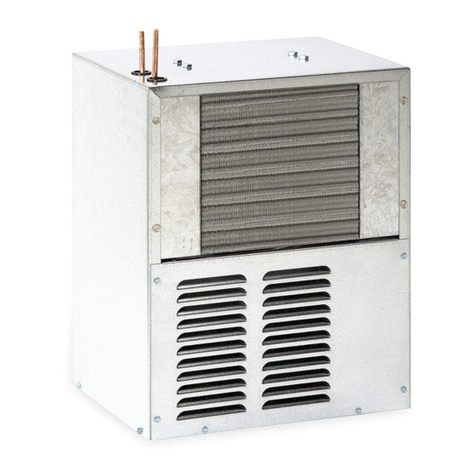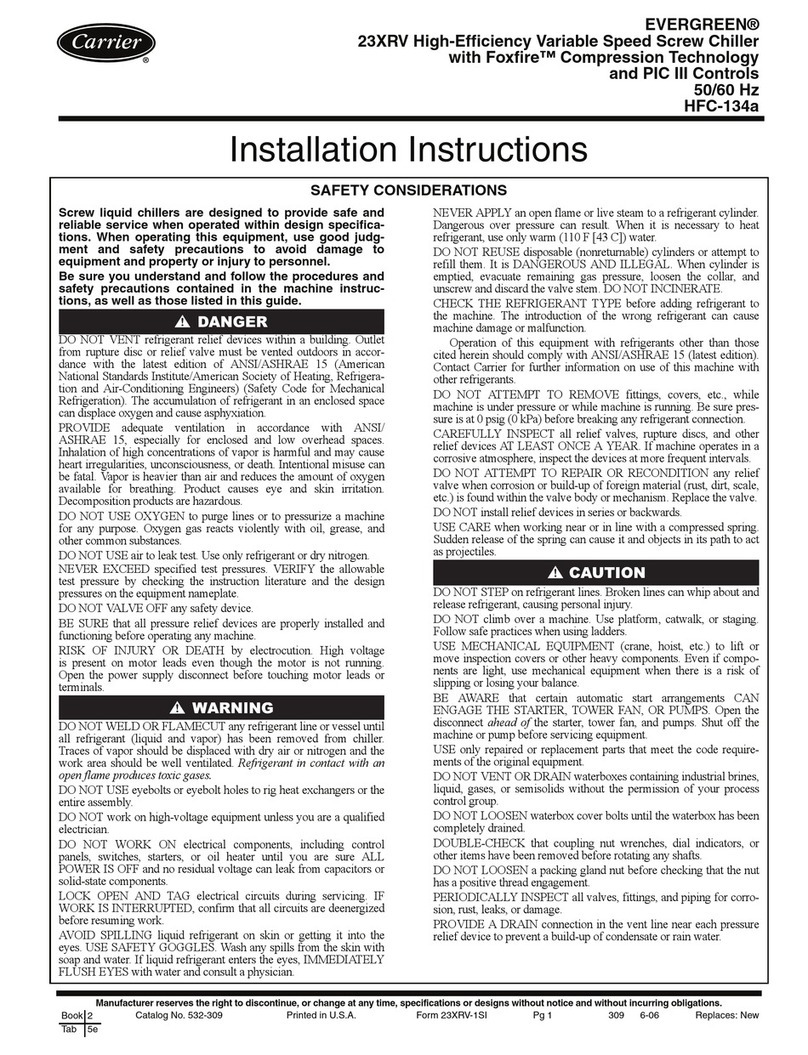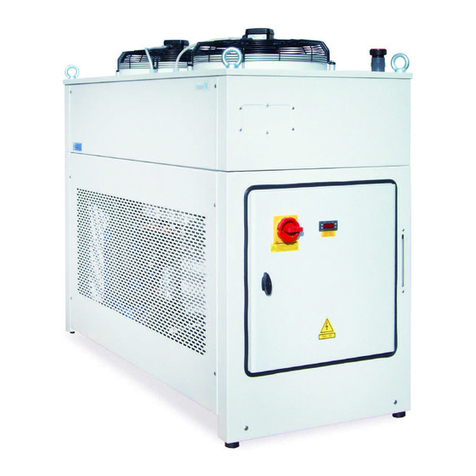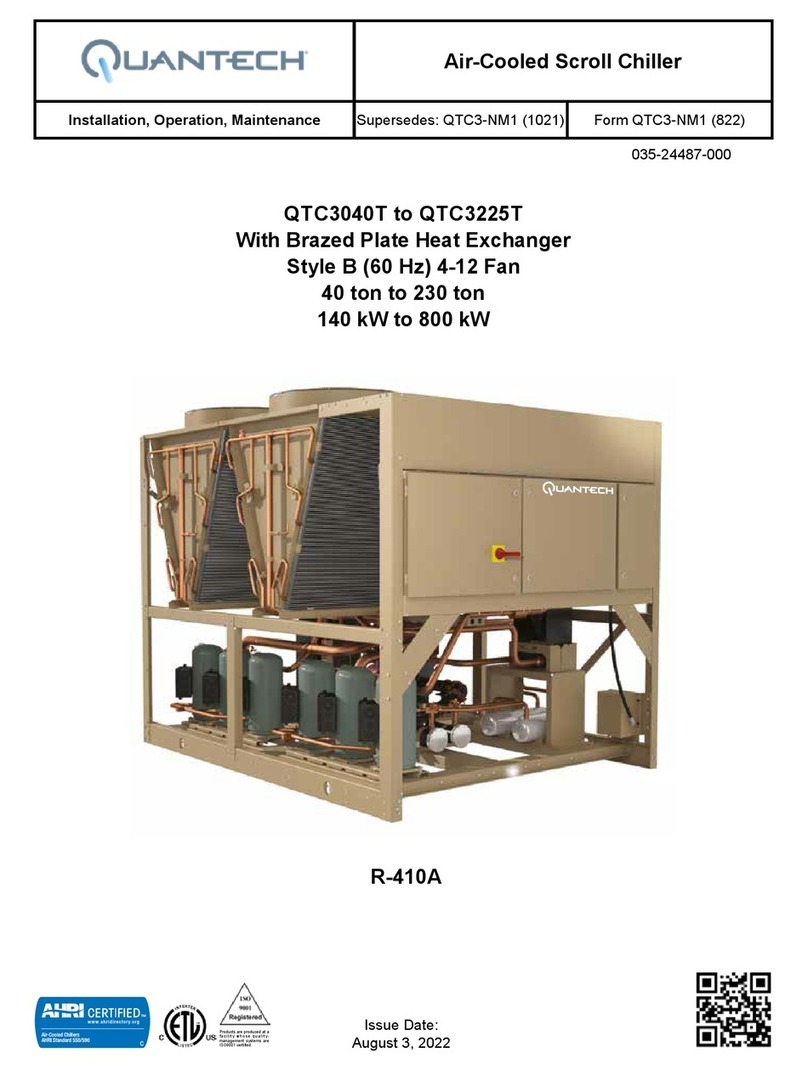TATA Motors TSH Series Quick start guide

Serie / Series
Emissione / Issue Sostituisce / Replaces
TSH 18÷151
09.05 05.04
ITALIANO / ENGLISH
MANUALE DI
INSTALLAZIONE
USO E
MANUTENZIONE
INSTALLATION,
USE AND
MANTEINANCE
MANUAL

2
TSH 18 ÷ 151
0. ELENCO DOCUMENTI ALLEGATI
Elencodocumentazionefornitaacorredodellamacchina
facente parte integrante del presente manuale.
- Quaderno tecnico
- Manuale microprocessore
- Certificato di garanzia
- Dichiarazione di conformità
- Schemi elettrici specifici
0. LIST OF ATTACHMENTS
List of documents supplied with the unit and forming
an integral part of this manual.
- Technical book
- Microprocessor manual
- Certificate of guarantee
- Declaration of conformity
- Specific electrical circuit

3
TSH 18 ÷ 151
INDICE CONTENTS
Argomento
ELENCO DOCUMENTI ALLEGATI
PREMESSA
Informazioni generali
Allegati
Avvertenze
DESCRIZIONE DELLA MACCHINA
Identificazione
Identificazione della macchina
Destinazione d'uso
Controindicazioni
Descrizione generale
SICUREZZA
Definizioni
Regole generali di sicurezza
Simbologia
Mappa dei segnali di sicurezza
Segnali di sicurezza
Dispositivi di emergenza e di sicurezza
Descrizione del rischio residuo
Rischio residuo in prossimità della macchina
Misure da adottare in caso di fuoriuscita di
gas frigorigeno
Operazioni con rimozione dei pannelli
ISPEZIONE, TRASPORTO
Ispezione
Stoccaggio
Sollevamento e trasporto
Disimballo
INSTALLAZIONE
Scelta del luogo di installazione
Collegamento idraulico
Generalità
Subject
LIST OF ATTACHMENTS
INTRODUCTION
General information
Attachments
Warnings
UNIT DESCRIPTION
Identification
Identification
Intended use
Contraindications
General description
SAFETY
Definition
General safety regulations
Symbols
Location of safety signs
Safety signs
Emergency and safety devices
Description of residue risks
Residue risks near the unit
Measures to take in case of leaking refrige-
rant gas
Operations with the panels removed
INSPECTION AND TRANSPORT
Inspection
Storage
Lifting and transport
Unpacking
INSTALLATION
Choosing the installation site
Water connections
General
Pag.
2
5
5
5
5
7
7
7
8
8
9
9
9
10
10
10
11
11
12
13
13
13
14
14
15
15
15
16
16
17
17
18
18
Page
2
5
5
5
5
7
7
7
8
8
9
9
9
10
10
10
11
11
12
13
13
13
14
14
15
15
15
16
16
17
17
18
18
19
0
1
1.1
1.2
1.3
2
2.1
2.1.1
2.2
2.3
2.4
3
3.1
3.2
3.3
3.3.1
3.3.2
3.4
3.5
3.5.1
3.5.2
3.5.3
4
4.1
4.2
4.3
4.4
5
5.1
5.2
5.2.1
0
1
1.1
1.2
1.3
2
2.1
2.1.1
2.2
2.3
2.4
3
3.1
3.2
3.3
3.3.1
3.3.2
3.4
3.5
3.5.1
3.5.2
3.5.3
4
4.1
4.2
4.3
4.4
5
5.1
5.2
5.2.1

4
TSH 18 ÷ 151
Evaporatore
Collegamenti elettrici
Generalità
Collegamento elettrico della pompa di circo-
lazione
Consensi esterni
AVVIAMENTO
Controlli preliminari all'avviamento
Messa in funzione
Verifiche durante il funzionamento
Generalità
Sbrinamento
(Solo unità pompa di calore)
Arresto del gruppo
FUNZIONAMENTO
Generalità
Fermata stagionale
RICERCA GUASTI
MANUTENZIONE E CONTROLLI PERIODICI
Avvertenze
Generalità
Controlli mensili
Controlli quadrimestrali
Riparazioni del circuito frigo
Rabbocchi di refrigerante
DISMISSIONE E SMALTIMENTO
5.2.2
5.3
5.3.1
5.3.2
5.3.3
6
6.1
6.2
6.3
6.3.1
6.3.2
6.4
7
7.1
7.2
8
9
9.1
9.1.1
9.1.2
9.2
9.3
10
Evaporator
Electrical connections
General
Electrical connections to the
circulation pump
External signals
START UP
Preliminary controls
Start up
Checks during unit operation
General
Defrosting
(Only heat pump units)
Stopping the unit
OPERATION
General
Seasonal shut down
TROUBLE SHOOTING
ROUTINE MAINTENANCE
AND CONTROLS
Warnings
General
Monthly controls
Four-monthly controls
Repairing the refrigerant circuit
Topping up the refrigerant liquid
SHUT DOWN AND DISPOSAL
5.2.2
5.3
5.3.1
5.3.2
5.3.3
6
6.1
6.2
6.3
6.3.1
6.3.2
6.4
7
7.1
7.2
8
9
9.1
9.1.1
9.1.2
9.2
9.3
10
20
20
21
21
22
22
24
25
25
26
26
27
27
27
28
32
32
32
33
33
33
33
34
35
19
20
20
21
21
22
22
24
25
25
26
26
27
27
27
28
32
32
32
33
33
33
33
34
35

5
TSH 18 ÷ 151
1. PREMESSA
1.1 INFORMAZIONI GENERALI
Questo manuale contiene le norme di installazione, uso
e manutenzione dei refrigeratori TSH, evidenziandone
rischi e pericoli connessi. Esso è stato espressamente
studiato e sviluppato per permettere al personale pre-
posto un utilizzo facile e in sicurezza dei refrigeratori
d’acqua TSH. Leggere attentamente e completamente
tutteleinformazioniinessoriportate.Prestareparticolare
attenzione alle norme evidenziate con
in quanto se non osservate possono causare danno alle
persone, all’ambiente e/o alla macchina stessa.
La società declina ogni responsabilità per qualsiasi uso
improprio della macchina, per modifiche alla stessa
non autorizzate o per la non osservanza delle norme
riportate sul manuale.
Il manuale deve essere conservato in luogo sicuro e
messo a disposizione del personale addetto alla con-
duzione ed alla manutenzione del refrigeratore.
1.2 ALLEGATI
Fanno parte integrale del presente manuale i documenti
evidenziati a pag. 2.
1.3 AVVERTENZE
Leunità TSH sono state progettatee costruite per garan-
tire nel tempo grande affidabilità di esercizio e massima
sicurezza; per questo e grazie alle scelte progettuali e
realizzative, la società può garantire la totale conformità
agli standard di sicurezza CE.
Ulteriore garanzia è assicurata dai collaudi cui la mac-
china è stata sottoposta in fabbrica.
All’utente resta quindi soltanto l’impegno di un uso
proprio e di una manutenzione preventiva conforme alle
indicazioni contenute in questo manuale.
Ogni intervento, di qualsiasi natura, sulla
macchina deve essere preceduto da una
attenta lettura del presente manuale in tutte
le sue parti.
1. INTRODUCTION
1.1 GENERAL INFORMATION
This manual contains the installation, use and mainte-
nance instructions for the TSH chillers, and highlights
all connected risks and perils. It has been expressly
prepared and written to allow authorised users to use
the TSH water chillers in complete safety and with the
greatest of ease. Please read the whole of this manual
with care, paying special attention to the sections
marked with
as non-compliance may cause harm to people, dete-
riorate the environment and/or damage the unit.
Thecompany declines all responsibility for any improper
use of the unit, unauthorised modifications or non-com-
pliance with the instructions contained in this manual.
Please keep this manual in a safe place and make it
available to chiller operators and maintenance men.
1.2 ATTACHMENTS
The documents shown on page 2 form an integral part
of this manual.
1.3 WARNINGS
The TSH units have been designed and built to ensure
long-term operating reliability and maximum safety;
for this reason and thanks to the company’s design
and construction policy, the company is able to guar-
antee that this product totally complies with EC safety
standards.
A further guarantee of this is provided by the factory
tests carried out on the unit.
The user, therefore, must only ensure the unit is properly
used and that maintenance operations are carried out
according to the indications contained in this manual.
Theunitshouldnotbetoucheduntilthewhole
of this manual has been carefully read.

6
TSH 18 ÷ 151
Il manuale di installazione, uso e manuten-
zione deve essere sempre a disposizione
degliaddetti,iquali, prima di ogni operazione
sulla macchina, devono obbligatoriamente
leggerlo.
This installation, use and maintenance man-
ual must always be kept within easy reach
of authorised staff who are obliged to read
it before carrying out any operations on the
unit.

7
TSH 18 ÷ 151
2 DESCRIZIONE DELLA MACCHINA
Questo capitolo ha lo scopo di fornire una descrizione
generale delle caratteristiche principali della macchina
nel suo insieme, unitamente a quella dei principali com-
ponenti, standard e opzionali.
2.1 IDENTIFICAZIONE
2.1.1 Identificazione della macchina
La macchina si identifica tramite le targhette poste sul
telaio e sul quadro elettrico. Le targhette riportano i
seguenti dati:
- Ragione sociale del costruttore
- Indirizzo del costruttore
- Designazione della serie e del tipo di unità
- Numero di matricola
- Anno di costruzione
- Tipo e quantità di refrigerante
- Massima pressione ammissibile
- Taratura dei pressostati
- Simbolo della certificazione CE
- Caratteristiche elettriche
- Identificazione schema elettrico
2 UNIT DESCRIPTION
This chapter contains a general description of the main
unit characteristics, together with those of its principal
standard and optional components.
2.1 IDENTIFICATION
2.1.1 Unit identification
The unit can be identified throug the plats attached on
the frame and in the electrical box. This label contains
the following information:
- Manufacturer’s name
- Manufacturer’s address
- Description of the series and type of unit
- Series number
- Year of construction
- Type and quantity of refrigerant liquid
- Max. Allowable pressure
- Pressure switch set point
- EC certification symbol
- Electrical characteristics
- Wiring diagram identification
Modello/Model Matricola/Serial number
Modell/Modèle Matrikelnr/Matricule
Tensioni-Fasi-Frequenza Tensioni circuiti ausiliari
Voltage-Phases-Frequency Auxiliary circuit voltage
Spannung-Phasen-Frequenz Hilfstromkreisspannung
Tel. 0438 2661
Fax. 0438 266380
Tension-Phases-Fréquence Tension circuits auxiliaires
V
Corrente massima assorbita Corrente massima di spunto
Web: www.tata.it
Max absorbed current Max starting current
Maximale Stromaufnahme Max Anlaufstrom
Courant maxi absorbée Courant maxi de démarrage
AA
Modello/Model
Tipo di refrigerante Carica refrigerante per circuito
Modell/Modèle
Refrigerant type Refrigerant charge per circuit
Kältemittel Typ Kältemittelfüllung pro Kreislauf
Matricola/Serial number
Type de réfrigerant Charge de réfrigerant chaque circuit
Matrikelnr/Matricule
kg
Taratura pressostato di alta Press. massima circuito idraulico
Anno di costruzione
High pressure switch setting Max hydraulic circuit pressure
Construction year
HD-Wächter Einstellung Max. Druck im hydraul. Kreislauf
Baujahr
Préssion maxi refrigerant Préssion maxi circuit hydraulique
Année de fabrication
Bar Bar
Gruppo del fluido frigorifero Data di produzione
PS Max.Press.ammissibile
Group of the refrigerant fluid Manufacturing date
Max Working press.Refrig.side
Kältemittel Klasse Herstellungsdatum
Max Betriebsdruck Kältemittelseitug
Groupe de fluide frigorifique Date de fabrication
Press.max.de travail cute refrigerant
28 bar
20 bar
ALTA
HIGH PRESS.
HOCHDUCK
HAUTE
BASSA
LOW PRESS.
NIEDERDUCK
BASSE
28 bar
20 bar
ALTA
HIGH PRESS.
HOCHDUCK
HAUTE
BASSA
LOW PRESS.
NIEDERDUCK
BASSE
28 bar
20 bar
ALTA
HIGH PRESS.
HOCHDUCK
HAUTE
BASSA
LOW PRESS.
NIEDERDUCK
BASSE
28 bar
20 bar
ALTA
HIGH PRESS.
HOCHDUCK
HAUTE
BASSA
LOW PRESS.
NIEDERDUCK
BASSE
bar
bar
ALTA
HIGH PRESS.
HOCHDUCK
HAUTE
BASSA
LOW PRESS.
NIEDERDUCK
BASSE
TATA S.p.A
Via Europa
31020 S.Fior (TV) - ITALY
TATA S.p.A
Via Europa
31020 S.Fior (TV) - ITALY

8
TSH 18 ÷ 151
2.2 DESTINAZIONE D’USO
TSH sono refrigeratori con condensazione ad aria de-
stinati a raffreddare acqua (eventualmente addizionata
con glicole etilenico inibito) che circola in un anello
chiuso. Le unità a pompa di calore (TSH...WP) possono,
aseconda del ciclo di funzionamento scelto, raffreddare
o riscaldare l’acqua dell’anello.
Ilcaldo,oilfreddo,cosìprodottopuò essere utilizzato per
impianti di climatizzazione o per processi industriali.
2.3 CONTROINDICAZIONI
Non impiegare in prossimità della macchina
prodotti infiammabili.
Non impiegare in prossimità della macchi-
na sostanze in grado di formare miscele
esplosive.
Non impiegare la macchina dove sussistono
problemi di impatto ambientale (vedi punto
3.5 pag. 13).
2.4 DESCRIZIONE GENERALE
Tutte le strutture sono realizzate in peraluman. La strut-
turaèautoportanteedipannellisonofacilmenterimovibili
in modo da permettere l’accesso all’interno della unità
per le operazioni di manutenzione e riparazione.
Gli schemi funzionali e la componentistica usata sono
allegati.
3 SICUREZZA
3.1 DEFINIZIONI
In questo documento verranno utilizzate le seguenti
definizioni:
- Zone pericolose: qualsiasi zona all’interno e/o in
prossimità della macchina in cui la presenza di una
personaesposta costituisca un rischio perla sicurezza
e la salute di detta persona.
- Persona esposta: qualsiasi persona che si trovi inter-
namente o in parte in una zona pericolosa.
- Operatore/Manutentore: la o le persone incaricate di
far funzionare, regolare, eseguire la manutenzione,
riparare, movimentare la macchina.
3.2 REGOLE GENERALI DI SICUREZZA
2.2 INTENDED USE
The TSH series of air condensation chillers have been
designed to cool water (possibly containing inhibited
ethylene glycol) circulating in a closed circuit. The heat
pump units (TSH...WP) can cool or heat the water in
the closed circuit depending on which operating cycle
is chosen.
The heat or cold produced can be used for air-condi-
tioning systems or industrial processes.
2.3 CONTRAINDICATIONS
Do not use inflammable products near the
unit.
Do not use substances that can form ex-
plosive mixtures near the unit.
Do not use the unit in conditions that could
be harmful for the environment (see point
3.5 on page 13).
2.4 GENERAL DESCRIPTION
All the unit structures are made from peraluman. The
structure is free standing and the panels are easy to
remove in order to allow access to the inside of the unit
for maintenance and repair operations.
The functional diagrams and the components used are
attached to this manual.
3SAFETY
3.1 DEFINITION
This document uses the following definitions:
- Dangerous areas: any area inside and/or near to the
unit in which the presence of a person would give rise
to a risk for that person’s health.
- Exposed person: anyone who is wholly or partly inside
a dangerous area.
- Operator/Maintenance man: person or persons au-
thorised to operate, adjust, service, repair or move
the unit.

9
TSH 18 ÷ 151
È vietato alle persone non autorizzate avvi-
cinarsi alla macchina.
Prima di ogni intervento di manutenzione
sulla macchina, seguire scrupolosamente
quanto indicato nel capitolo 9 a pag. 32.
È vietato l’ingresso all’interno della mac-
china. L’accesso è consentito solo al perso-
nale qualificato e solo a macchina ferma.
Èvietatalarimozionedelleprotezioniel’esclusio-
ne dei dispositivi di sicurezze e di emergenza.
È vietato stazionare sulla macchina.
- Impiegare la macchina solo per l’uso a cui essa è
destinata.
- Il costruttore non risponde dei danni derivanti da un
impiego improprio della macchina o da modifiche
tecniche effettuate sulla macchina.
- Controllare regolarmente se i dispositivi di sicurezza
presentano un funzionamento corretto.
- Non smontare, modificare o mettere fuori funzione
parti della macchina.
- Per tutti gli interventi da effettuare sulla macchina,
utilizzare esclusivamente attrezzi ed equipaggiamenti
idonei e in buone condizioni. Gli operatori dovranno
indossare i normali dispositivi di protezione individuali
(guanti, casco, occhiali, ecc.).
- I lavori sull’equipaggiamento elettrico devono essere
eseguiti solo da un elettricista qualificato.
- Gli interventi sul circuito frigorifero possono essere
effettuati solo da personale specializzato.
3.3 SIMBOLOGIA
Verificare periodicamente lo stato delle targhette e
provvedere, in caso di necessità, al loro ripristino.
3.3.1 Mappa dei segnali di sicurezza
3.2 GENERAL SAFETY REGULATIONS
It is forbidden for unauthorised persons to
approach the unit.
Scrupulously observe the contents of Chap-
ter 9 on page 32 before carrying out each
maintenance operation on the unit.
It is forbidden to enter the unit. Access is
only permitted to qualified staff when the
unit is disconnected.
It is forbidden to remove safety guards and
by-pass safety and emergency devices.
It is forbidden to stand on the unit.
- Only use the unit to do what it was built for.
- Themanufacturerdeclines all responsibility for damage
deriving from improper use or technical modifications
made to the unit.
- Check the safety devices are in perfect working order
on a regular basis.
- Do not dismount, modify or disconnect unit parts.
- When working on the unit, only use suitable tools and
equipment in good condition. Operators must wear
normalpersonalprotectionequipment(gloves,helmet,
goggles, etc.).
- Work on the electrical system of the unit may only be
carried out by a qualified electrician.
- Work on the refrigerant circuit may only be carried out
by specialised staff.
3.3 SYMBOLS
Check the state of the plates on a regular basis and
repair them if necessary.
3.3.1 Location of safety signs
5
4
61
3
2
7

10
TSH 18 ÷ 151
3.3.2 Segnali di sicurezza 3.3.2 Safety signs
6
1
2
3
4
5
ATTENZIONE
• DARE TENSIONE AI RISCALDATORI OLIO DEL CARTER ALMENO 12 ORE PRIMA
DELL’AVVIAMNETO DELL’UNITÀ NEGLI INTERVALLI DI FUNZIONAMENTO (AD
ES. PAUSA DEL FINE SETTIMANA) TOGLIERE L’ALIMENTAZIONE ELETTRICA.
• L’UNITÀ È MUNITA DI UN RITARDATORE ANTIRICIRCOLO E DI DISPOSITIVO PER
LA RIPARTENZA AUTOMATICA.
• PRIMA DI APRIRE IL SEZIONATORE FERMARE L’UNITÀ AGENDO SUGLI APPOSITI
INTERRUTTORI DI MARCIA O IN ASSENZA SUL COMANDO A DISTANZA.
• PRIMA DI ACCEDERE A PARTI INTERNE DELL’UNITÀ TOGLIERE TENSIONE
APRENDO IL SEZIONATORE GENERALE.
WARNING
• SUPPLY THE CRANKCASE HEATERS AT LEAST 12 HOURS BEFORE STARTING
THE UNIT DURING TEMPORARY STOP PERIODS (LIKE WEEK÷ENDSI NEVER
DISCONNECT ELECTRICAL SUPPLY TO THE UNIT.
• THE UNIT IS PROVIDED WITH DELAY RELAY AND WITH AUTOMATIC RESTART
DEVICE.
• BEFORE OPENING THE MAIN SWITCH, STOP THE UNIT BY ACTING ON THE
SUITABLE RUNNING SWITCHES OR THESE ARE IF NOT PRESENT, ON THE
REMOTE CONTROL.
• BEFORE SERVICING THE INNER COMPONENTS, DISCONNECT ELECTRICAL
SUPPLY BY OPENING THE MAIN SWITCH.
ACHTUNG
• DIEKURBELWANNENHEIZUNGMINDESTENS12STUNDENVORDERINBETRIEB-
NAHMEDESGERATSUNTERSPANNUNGSETZEN DIE KURBELWANNENHEIZUNG
WAHREND DER STILLSTANDSZEITEN DES GERATS NICHT AUSSCHALTEN.
• DAS GERAT IST MIT SCHALTVERZOGERUNGSTIMER UND VORRICHTUNG FÜR
AUTOMATISCHEN WIEDERANLAUF AUSGESTATTET.
• VOR DEM OFFNEN DES HAUPTSCHALTERS SETZEN SIE DAS GERAT DURCH
BETATIGUNGDERENTSPRECHENDENBETRIEBSSCHALTERODERWENNDIESE
NICHT VORHANDEN SIND, DURCH FERNBEDIENUNG AUSSER BETRIEB.
• BEVOR MAN DIE INTERNE GERATEKOMPONENTEN BERUHRT. MUSS DER
HAUPTSCHALTER GEOFFNET WERDEN.
NOTICE
• FOURNIR TENSION AUX RECHAUFFERS DU CARTER AU MOINS 12 HEURES
AVANT QUE L’UNITÉ SOIT DÉMARÉE NE COUPEZ PAS LA TENSION AUX
RÉCHAFFEURS PENDANTS DES COURTES PERIODES D’ARRET DE L’UNITE.
TELS QUE LE WEEK-END.
• L’UNITÉ EST EQUIPPÉE DE RELAIS ANTI COURT-CYCLE ET D’UN DISPOSITIF
POUR LE REDEMARRAGE AUTOMATIQUE.
• AVANTD’OUVRIRLESÉCTIONNEURGENERALARRETEZ L’UNITÉ EN AGISSANT
SUR LES INTERRUPTEURS DE MARCHE OU AU CAS OU IL N’YA PAS SUR LE
COMMENDE Á DISTANCE.
• AVANT DE TOUCHER LES COMPOSANT INTERNES A L’UNITÉ, COUPER LA
TENSION EN OUVRANT LE SECTIONNEUR GÉNÉRAL.
INGRESSO ACQUA REFRIGERATA
CHILLED WATER INLET
KALTWASSEREINTRITT
ENTRÉE EAU GLACÉE
USCITA ACQUA REFRIGERATA
CHILLED WATER OUTLET
KALTWASSERAUSTRITT
SORTIE EAU GLACÉE
SFIATO ARIA
AIR PURGE
ENTLÜFTUNGSVENTIL
PURGE AIR
- PRESENZA DI ORGANI IN MOVIMENTO
- PRESENCE OF MOVING OBJECTS
- ANWESENHEIT VON GEGENSTÄNDEN
IN BEWEGUNG
- PRESENCE DES ORGANS EN MOUVEMENT
-INSTALLARE SEMPRE UN FILTRO ACQUA SULCIRCUITO IDRAULICO
A PROTEZIONE DELL’ EVAPORATORE.
-PLEASE BUILT ALWAYS AWATER FILTER ON THE HYDRAULIC
CIRCUIT TO PROTECT THE EVAPORATOR.
-EIN WASSERFILTER AUFDEM HYDRALISCHEN KREIS ZUM SCHUTZ
DES VERDAMPFERS IMMER EINBAUEN.
-INSTALLER TOUJOURS UN FILTRE DE L’EAU SUR LE CIRCUIT
HYDRAULIQUE A PROTECTION DE L’ EVAPORATEUR.
7
ATTENZIONE
ATTENTION
VORSICHT
!!

11
TSH 18 ÷ 151
3.4 DISPOSITIVI DI EMERGENZA E DI
SICUREZZA
Un dispositivo di emergenza che tolga ten-
sione dalla macchina deve essere previsto
all’esterno della stessa a cura di chi installa
la macchina.
3.5 DESCRIZIONE DEL RISCHIO RESIDUO
La descrizione del rischio residuo prende in consider-
azione i seguenti elementi:
- a quale tipologia di pericoli è soggetto chi opera nel-
l’ambito della macchina;
- la descrizione dei principali pericoli;
- chi può essere esposto a tali pericoli;
- quali sono le principali misure di sicurezza adottate
per ridurre il rischio di infortuni.
Le indicazioni per la prevenzione degli infortuni di segui-
to riportate, con riferimento alle relative aree a rischio
residuo, devono essere integrate con tutte le indica-
zioni generali del presente capitolo e con le norme di
prevenzione infortuni vigenti nel paese di destinazione
dell’impianto.
3.5.1 Rischio residuo in prossimità della macchina
- Folgorazione,senon vengono effettuati correttamente
l’allacciamento elettrico e la messa a terra della mac-
china.
- Tagli o escoriazioni per la presenza di superfici ta-
glienti.
- Aspirazione e successiva dispersione in ambiente
delle sostanze presenti sul luogo dell’installazione.
- Proiezione di eventuali oggetti che possano cadere
sulle pale dei ventilatori.
- Fuoriuscita di acqua (in caso di anomalia).
- Formazione di acqua di condensa e di ghiaccio nella
zona antistante la macchina durante il funzionamento
in riscaldamento delle macchine a pompa di calore.
- Alterazione del microclima (durante il funziona-
mento).
- Emissione di rumore (durante il funzionamento).
- Fuoriuscita di olii (per anomalia).
- Fuoriuscita del frigorigeno (per anomalia).
N.B. Il frigorigeno è una sostanza ad effetto serra.
Si tratta di vapori più pesanti dell’aria e che
possono provocare soffocamento riducendo
l’ossigeno disponibile per la respirazione. Una
rapida evaporazione del liquido può causare
congelamento.
3.4 EMERGENCY AND SAFETY DEVICES
An emergency external circuit breaker must
be fitted by the unit installer to disconnect
the unit from the power supply.
3.5 DESCRIPTION OF RESIDUE RISKS
The description of residue risks includes the following
elements:
- the kind of danger the people working on the unit are
subjected to;
- description of the main dangers;
- who is exposed to such dangers;
- the main safety methods used to reduce the risk of
injury.
The following accident prevention instructions, with
reference to the relative areas concerned by residue
risks, must be integrated with all the general indica-
tions contained in the present chapter and with the
accident prevention regulations in force in the country
of installation.
3.5.1 Residue risks near the unit
- Electrocution if the unit is not properly corrected to
the mains power supply and earth circuit.
- Cuts or abrasions caused by sharp surfaces.
- Extraction and subsequent dispersion in the envi-
ronment of substances present in the installation
site.
- Ejection of objects falling on the fan blades.
- Leaking water (in case of malfunction).
- Formation of condensation and ice in front of the unit
while the unit heat pumps are working.
- Alteration of the micro climate (during operation).
- Noise (during operation).
- Leaking oil (in case of malfunction).
- Leaking refrigerant liquid (in case of malfunction).
N.B. Refrigerant liquid is a substance which causes a
greenhouse effect. Its vapours are heavier than
air and can cause suffocation by reducing the
amount of oxygen available for breathing. Rapid
evaporation of the liquid can cause freezing to
occur.

12
TSH 18 ÷ 151
3.5.2 Misure da adottare in caso di fuoriuscita di
gas frigorigeno
- Tipo di prodotto:
R407C
- Misure di pronto soccorso:
Informazione generale:
non somministrare alcunchè a persone svenute.
Inalazione:
portare all’aria aperta. Ricorrere all’ossigeno o alla
respirazione artificiale se necessario. Non sommi-
nistrare adrenalina o sostanze similari.
Contatto con gli occhi:
sciacquare accuratamente ed abbondantemente
con acqua per almeno 15 minuti e rivolgersi ad un
medico.
Contatto con la pelle:
Lavaresubito abbondantementeconacqua.Togliersi
immediatamente tutti gli indumenti contaminati.
- Misure in caso di fuoriuscita accidentale:
Precauzioni individuali:
evacuareil personale inaree di sicurezza.Prevedere
unaventilazioneadeguata.Usare mezzi di protezione
personali.
Precauzioni ambientali:
intercettare l'emissione.
Metodi di pulizia:
impiegare prodotti assorbenti.
3.5.3 Operazioni con rimozione dei pannelli
Alcune delle operazioni e/o verifiche di seguito descritte
richiedono la rimozione dei pannelli del refrigeratore per
accedere all’interno dello stesso.
Prima di rimuovere qualsiasi pannello pe-
rimetrale, eccezion fatta per quello che
protegge il quadro elettrico, è obbligatorio
togliere tensione.
Si fa presente che all’interno dell’unità, anche a mac-
china ferma possono esserci superfici calde (tubazioni,
compressore, ecc.), o fredde (compressore, separatore
d’aspirazione, ecc.), taglienti (alette batterie) o corpi in
movimento (ventilatori).
Pertanto tali operazioni devono essere ef-
fettuate solo da personale qualificato che
indossi indumenti di sicurezza.
3.5.2 Measures to take in case of leaking refrigerant
gas
- Product type:
R407C
- First aid measures:
General information:
Do not give anything to people who have fainted.
Inhalation:
take the person out into the open air. Use oxygen
or artificial respiration if necessary. Do not give
adrenaline or similar substances.
Contact with eyes:
carefully rinse with abundant water for at least 15
minutes and see a doctor.
Contact with the skin:
Wash with abundant water and remove all contami-
nated clothing immediately.
- Measures to take in case of accidental leaking:
Personal precautions:
evacuate all staff to safety areas. Make sure the
area is suitably ventilated. Use personal protection
equipment.
Environmental precautions:
to intercept the emission.
Cleaning methods:
to employ absorbent products.
3.5.3 Operations with the panels removed
Someof the following operationsand/or controls require
the panels of the unit to be removed in order to access
the inside of the unit.
Before removing an outer panel, except for
the one protecting the electrical panel, the
unit must be disconnected from the mains
power supply.
Please note that some surfaces inside the unit may be
hot(piping,compressor,etc.), cold (compressor, suction
separator, etc.), sharp (coil fins) or moving (fans) even
when the unit is not working.
These operations may only be carried out by
qualified staff wearing safety clothing.

13
TSH 18 ÷ 151
Verifiche di funzionamento possono richiedere il funzio-
namento (totale o parziale dell’unità) con un pannello
aperto. In tal caso il pannello va rimosso a macchina
ferma.
Queste verifiche sono particolarmente peri-
colosee sono pertantoriservate a personale
altamente qualificato.
Operare come segue:
- Togliere tensione tramite l’interruttore generale.
- Aprire il quadro elettrico e disattivare, togliendo i
relativi fusibili, gli organi di cui non è necessario il
funzionamento per la verifica che si deve effettuare.
- Richiudere il quadro elettrico.
- Rimuovere il pannello interessato.
- Avviare l’unità.
- Effettuare le verifiche richieste con la massima cautela
e con l’utilizzo di protezioni individuali.
- Completate le verifiche, arrestare l’unità e rimettere
al suo posto il pannello precedentemente tolto.
- Togliere tensione e rimettere al loro posto gli eventuali
fusibili precedentemente tolti.
- Richiudere il quadro elettrico.
Operating checks may require the unit to work (totally
or partially) while a panel is open. In this case the panel
should be removed when the unit is not working.
These checks are particularly dangerous
and may only be carried out by highly qual-
ified staff.
Proceed as follows:
- Turn off mains power with the main power switch.
- Openthe electrical panel and removethe relative fuses
to disconnect the components that do not need to be
working in order to carry out the relative check.
- Close the electrical panel.
- Remove the panel in question.
- Start the unit.
- Carry out the relative check with the greatest of care
and using personal protection equipment.
- After completing the check, stop the unit and put the
panel back in place.
- Turn off mains power and put back any fuses that
were previously removed.
- Close the electrical panel.

14
TSH 18 ÷ 151
4. ISPEZIONE, TRASPORTO
4.1 ISPEZIONE
All’atto del ricevimento dell’unità, verificarne l’integrità.
Poiché la macchina è stata accuratamente controllata
prima di lasciare la fabbrica, eventuali danni sono da
imputare al trasportatore. Si raccomanda perciò di an-
notarli sul Foglio di Consegna prima di controfirmarlo.
Avvisaretempestivamentela società o l’Agentesull’entità
del danno riportato dall’unità.
Il Cliente deve sempre compilare un rapporto scritto che
riguarda ogni eventuale danno subito dalla macchina.
4.2 STOCCAGGIO
Latemperatura dell’ambiente in cui vengono immagazz-
inate le unità deve essere compresa tra -20 e +50°C.
4.3 SOLLEVAMENTO E TRASPORTO
Durante lo scarico ed il posizionamento dell’unità, pre-
stare molta attenzione alle manovre che non devono in
alcun modo essere brusche e/o violente. Non utilizzare
come punti di sollevamento le tubature o altri compo-
nenti della macchina.
Attenzione!
Intutte le operazioni di sollevamento assicu-
rarsi di aver ancorato saldamente l’unità per
evitare ribaltamenti o cadute accidentali.
4.4 DISIMBALLO
L’imballo va tolto solo quando l’unità è giunta sul posto
di installazione e non dovrà più essere movimentata.
Rimuovere con cura l’imballo della macchina, evitando
di danneggiare la stessa.
Poiché i materiali che costituiscono l’imballo sono di
naturadiversa (legno, nylon,polistirolo, cartone, ecc.), si
consiglia di conservarli separatamente e di consegnarli
alleditte specializzate nello smaltimento e nel riciclaggio
degli stessi allo scopo di salvaguardare l’ambiente.
4. INSPECTION AND TRANSPORT
4.1 INSPECTION
Check the condition of the unit on receipt. As the unit
was carefully checked before leaving the factory, any
claims for damages should be addressed to the for-
warder. Any damage should therefore be indicated on
the Delivery Note before signing it.
Please inform the company or the Agent of the nature
of the damage to the unit immediately.
The Customer must always write a report describing
any damage caused to the unit.
4.2 STORAGE
The temperature in the area where the units are stored
must range between -20 and +50°C.
4.3 LIFTING AND TRANSPORT
Whenunloading and positioning the unit, take great care
not to make sudden and/or violent manoeuvres. Do not
lift the unit by its piping or any other components.
The unit should only be moved as shown in the plate
attached to it.
Attention!
Make sure the unit is securely anchored
before lifting it in order to prevent it from
accidentally overturning or falling.
4.4 UNPACKING
Only unpack the unit when it has reached the installation
site and no longer needs to be moved.
Remove the packing material with care, making sure
not to damage the unit.
Given that various kinds of packing materials are used
(wood, nylon, polystyrene, cardboard, etc.), they should
be separated and delivered to specialised disposal and
recycling companies for environmental reasons.

15
TSH 18 ÷ 151
5 INSTALLAZIONE
5.1 SCELTA DEL LUOGO DI INSTALLAZIONE
Nella scelta del luogo di installazione si dovrà tenere
conto di:
- Peso dell’unità:
Lasoletta di appoggiodell’unità deve essere
perfettamenteorizzontaleedingrado di sop-
portare il peso in funzionamento dell’unità.
Èopportunocostruireunasolettadisupportodidimen-
sioni proporzionate all’unità. Ciò si rende in particolar
modo necessario quando l’unità deve essere posta su
terreno instabile (giardini, terreni di riporto, ecc.).
La soletta deve:
• appoggiare su opportune fondamenta, avere un’al-
tezza, rispetto al terreno circostante, di circa 10-15
cm;
• essere orizzontale ed in grado di sopportare circa
il 200% del peso di esercizio della macchina. Si
consiglia di interporre una guarnizione di sughero
adeguatamente sigillata lungo il perimetro.
- Spazi:
È necessario verificare che gli spazi di
rispetto riportati sul foglio dimensionale
dell’unità siano lasciati liberi.
Ridurre lo spazio richiesto può significare difficoltà o
impossibilitàdieffettuare le operazioni dimanutenzione
e/o malfunzionamento dell’unità a causa di riduzione
dellaportatad’aria che investe la batteriacondensante
o di ricircolo della stessa.
Si fa presente che non sono ammessi osta-
coli quali tettucci, pensiline o coperture in
genere al di sopra della macchina.
Si tenga presente che le unità a pompa di calore
danno luogo a formazione di ghiaccio e condensa
che si riversa sul pavimento antistante l’unità. Si dovrà
pertantoprovvedere a raccoglieree drenare l’acqua di
condensa e sbrinamento per evitare che il pavimento
diventi sdrucciolevole.
Tutta la zona di rispetto dovrà essere in-
terdetta, fatta eccezione per gli operatori e
manutentori addetti alla macchina.
- Rumore:
Durante il suo funzionamento, l’unità genera del rumore,
evitare pertanto l’installazione in ambienti riverberanti.
L’unitàdovràessereposizionata con il lato batteria rivolto
nella direzione in cui la rumorosità è meno critica.
- Venti predominanti:
Il vento può alterare le condizioni di funzionamento, per
minimizzarnegli effettisiconsigliadi posizionare l’unitàconil
lato lungo parallelo alla direzione dei venti predominanti.
- Vibrazioni:
Benché le macchine trasmettano al terreno un basso
livellodivibrazioni, è in ogni casoconsigliabilefrapporre
fra il basamento delle stesse ed il piano di appoggio
un nastro di gomma rigido.
Quando si rende necessario un isolamento maggiore
è opportuno l’utilizzo di supporti antivibranti.
5 INSTALLATION
5.1 CHOOSING THE INSTALLATION SITE
When choosing the installation site the following points
should be considered:
- The weight of the unit:
The supporting surface under the unit must
be perfectly horizontal and able to withstand
its operating weight.
A supporting surface with an appropriate area should
be built. This is particularly important if the unit is in-
stalled on unstable ground (gardens, embankments,
etc.).
The supporting surface must:
• lie on suitable foundations and be about 10-15 cm
higher than the surrounding ground;
• be horizontal and able to withstand about 200%
of the weight of the unit in operation. A suitable
sealed layer of cork should be placed along the
perimeter.
- Spaces:
Make sure that sufficient free space, as in-
dicated on the scale drawing, is left around
the unit.
Less space will make it difficult or impossible to carry
out maintenance operations and/or lead to faults in
the unit due to the reduction in the air flow on the
condenser coil or its recirculation.
Please note that obstacles such as can-
opies, shelters or coverings in general are
not permitted.
Please note that the heat pump units cause ice and
condensation to form and drain onto the floor in front
of the unit. This water must therefore be collected and
drained to prevent the floor from becoming slippery.
People may not enter the unit area unless
they are authorised operators and mainte-
nance personnel.
- Noise:
The unit generates noise while it’s working; do not
install it in reverberating rooms. The unit must be po-
sitioned with the coil side facing the direction where
noise is less critical.
- Prevailing winds:
Wind may alter operating conditions; to minimise its
effects the unit should be positioned with the long side
parallel to the direction of prevailing winds.
- Vibrations:
Although the units transmit a low level of vibrations
to the ground, a sheet of rigid rubber should always
be placed between the unit base and the supporting
surface.
If greater insulation is required, vibration moisting
supports should be used.

16
TSH 18 ÷ 151
5.2 COLLEGAMENTO IDRAULICO
5.2.1 Generalità
Perla realizzazione delcircuito idraulico dell’acquarefri-
gerataèbuonanormaseguire attentamente le indicazioni
sotto riportate oltre che la normativa vigente.
Attenzione!
Le tubazioni idrauliche devono essere op-
portunamente staffate per non gravare con
il loro peso sul refrigeratore.
- Raccordare le tubazioni al refrigeratore tramite giunti
flessibilialfinedievitare la trasmissione delle vibrazioni
e compensare le dilatazioni termiche.
- Installare sulle tubazioni i seguenti componenti:
• valvole di intercettazione (saracinesche) per isolare
l’unità dal circuito idraulico;
• indicatori di temperatura e pressione per la normale
manutenzione e controllo del gruppo;
• pozzetti sulle tubazioni d’ingresso ed uscita per i
rilievi di temperatura, qualora non fossero presenti
indicatori di temperatura;
• filtro metallico (tubazione in ingresso) a rete con
maglia non superiore ad 1mm, per proteggere lo
scambiatore da scorie o impurità presenti nelle
tubazioni;
• valvola di taratura per la regolazione della portata
acqua
• valvole di sfiato, da collocare nelle parti più elevate
del circuito idraulico, per permettere lo sfogo del-
l’aria;
• vaso di espansione, dimensionato in fun-
zione della quantità d’acqua contenuta
nell’impianto e delle escursioni termiche
prevedibili, e valvole di carico automatico
per il mantenimento della pressione del
sistema e per compensare le dilatazioni
termiche del fluido.
• rubinetto di scarico e, ove necessario, serbatoio di
drenaggio per permettere lo svuotamento dell’im-
pianto per le operazioni di manutenzione o le pause
stagionali.
5.2 WATER CONNECTIONS
5.2.1 General
Please carefully carry out the following instructions and
observe current law when installing the chilled water
circuit.
Attention!
The water pipes must be suitably supported
with brackets in order not to weigh on the
chiller.
- Connect the pipes to the chiller with flexible joints in
order to prevent the transmission of vibrations and to
compensate thermal expansion.
- Install the following components on the pipes:
• shut-off valve (moisters) for shutting off the water
mains;
• temperature and pressure gauges for routine main-
tenance and inspection purposes;
• check points on the inlet and outlet pipes for meas-
uring temperatures if temperature indicators are not
fitted;
• metalfilter(inletpipe)witha maximum mesh aperture
of 1 mm to protect the exchanger from waste or
impurities in the pipes;
• waterflow control valve
• relief valves, fitted in the uppermost parts of the
water circuit, for expelling air;
• expansion tank of a suitable size for the
quantity of water contained in the system
and the expected temperature range, and
an automatic inlet valve for maintaining the
pressure of the system and compensating
the thermal expansion of the fluid.
• drain valve or, where necessary, drain tank for
emptying the circuit for maintenance operations or
seasonal shut downs.

17
TSH 18 ÷ 151
5.2.2 Evaporatore
Èdi importanza fondamentale chel’ingresso
dell’acqua avvenga in corrispondenza della
connessionecontrassegnataconlatarghetta
“ENTRATA ACQUA”.
Per gli attacchi idraulici vengono utilizzate connessioni
filettate maschio o flangiate, a seconda dei modelli (fare
riferimento ai disegni dimensionali, così come per la
posizione degli attacchi).
È di fondamentale importanza realizzare il
circuito idraulico in modo tale che venga
garantita la costanza della portata d’acqua
allo scambiatore in qualsiasi condizione di
funzionamento.
È buona norma installare una valvola di
sicurezza sul circuito idraulico. In caso di
anomaliegravinell’impianto(ades.incendio)
essa permetterà di scaricare il sistema evi-
tando possibili scoppi. Collegare sempre lo
scarico ad una tubazione di diametro non
inferiore a quello dell’apertura della valvola,
e convogliarlo in zone nelle quali il getto non
possa recare danno alle persone.
Attenzione!
Duranteleoperazionidiallacciamento idrau-
lico non operare mai con fiamme libere in
prossimità o all’interno dell’unità.
5.2.2 Evaporator
It is vitally important that the water enters
the unit from the connection point marked
with the “WATER INLET” plate.
Threaded or flanged male unions, depending on the
models, are used to make water connections (please
refer to the scale drawings which also show the posi-
tion of the unions).
It is vitally important to connect the water
circuit so that the flow of water to the ex-
changer is always constant under all oper-
ating conditions.
Asafetyvalve should be installed on thewater
circuit. In case of serious system faults (e.g.
fire) this will allow the system to be drained
in order to prevent the risk of explosions.
Always connect the drain to a pipe with a
diameternot less than that of the valveopen-
ing and install the outlet in an area where the
jet cannot cause harm to people.
Attention!
While connecting the water circuit, never
work with naked flames near to or inside
the unit.

18
TSH 18 ÷ 151
1 = Giunti antivibranti
2 = Valvola di intercettazione a sfera
3 = Valvola di ritegno
4 = Pompa di circolazione
5 = Filtro a rete
6 = Gruppo di carico acqua automatico
7 = Vaso di espansione chiuso
8 = Valvola di sicurezza
9 = Serbatoio di accumulo acqua
10= Termometri
11= Sfiato aria automatico
12= Manometro
E = Evaporatore
5.3 COLLEGAMENTI ELETTRICI
5.3.1 Generalità
Queste operazioni devono essere effettuate
solo da personale specializzato.
Prima di effettuare qualsiasi operazione su
parti elettriche assicurarsi che non vi sia
tensione.
Verificare che l’energia disponibile corrisponda ai dati
nominali dell’unità riportati sulla targhetta (tensione,
numero di fasi, frequenza).
Icollegamentielettricidevonoessereeffettuatiseguendo
attentamenteleistruzioni riportate sullo schema elettrico
allegato all’unità.
Il collegamento a terra è obbligatorio per legge. Si deve
perciò provvedere al collegamento del cavo di terra con
la barra di terra situata nel quadro elettrico e contras-
segnata con PE.
1 = Vibration-proof joints
2 = ball shut-off valve
3 = Check valve
4 = Circulation pump
5 = Mesh filter
6 = Automatic water filling valve
7 = Closed expansion tank
8 = Safety valve
9 = Water storage tank
10= Thermometers
11= Automatic air purge
12= Pressure gauge
E = Evaporator
5.3 ELECTRICAL CONNECTIONS
5.3.1 General
These operations may only be carried out
by specialised staff.
Before carrying out any operations on elec-
trical components, make sure the unit is dis-
connected from the mains power supply.
Make sure that the mains power supply corresponds to
the rated values of the unit shown on the plate (voltage,
number of phases, frequency).
Electrical connections must be made carefully following
the instructions shown on the wiring diagram attached
to the unit.
The earth connection is obligatory by law. The earth
cable must be connected to the earth bar located in
the electrical panel and marked with PE.
-
6
6
!
.
"
#
$
'
&
%
E
12 10
11
2
T
F
11
12 10
T
2
23
4
52
78
11
9
2
6
1
1
Schema di collegamento impianto idraulico
Hydraulic circuit connection diagram

19
TSH 18 ÷ 151
L’alimentazione del circuito ausiliario è derivata dalla
linea di potenza tramite un trasformatore situato nel
quadro elettrico.
La sezione del cavo e le protezioni di linea
devono essere conformi a quanto indicato
nelloschemaelettricoenell’appositascheda
allegata all’unità.
Rispettare la sequenza delle fasi, viceversa la macchina
non potrà funzionare.
La tensione di alimentazione non deve subire variazioni
superiori a ±5% e lo squilibrio tra le fasi deve essere
sempre inferiore al 2%.
Il funzionamento deve avvenire entro i valori
sopra citati, pena la decadenza immediata
della garanzia.
5.3.2 Collegamento elettrico della pompa di
circolazione
La pompa di circolazione deve sempre essere colle-
gata al controllo dell’unità come previsto dallo schema
elettrico.
La pompa deve essere avviata prima della
partenza del refrigeratore e fermata dopo
l’arresto di quest’ultimo (ritardo minimo
consigliato: 40 secondi).
5.3.3 Consensi esterni
Qualora si desideri effettuare un ON-OFF remoto del-
l’unità è necessario collegare il consenso esterno ai
contatti indicati sullo schema elettrico.
Per il collegamento elettrico al contatto ON-OFF remoto
efunzionamentoCHILLER-POMPA DI CALORE remoto,
non installare i cavi di comando all’interno delle canaline
usate per i cavi di potenza; nel caso non fosse possibile,
utilizzare un cavo schermato.
Quandosi effettuano icollegamenti descritti
ai paragrafi 5.3.2 - 5.3.3 attenersi scrupo-
losamente a quanto riportato nello schema
elettrico.Icavidicollegamentodevonoavere
sezione minima di 1,5 mm².
Auxiliary circuit power is supplied by the power line by
means of a transformer located in the electrical panel.
The cross-section of the cable and the line
protectionsmustcomplywiththeindications
shown on the wiring diagram and in the rela-
tive sheet attached to the unit.
Observe the phase sequence, otherwise the unit will
not work.
Input voltage must not exceed variations of over ±5%
and phase unbalance must always be less than 2%.
Unitoperation must always take place within
theabove values as otherwise the guarantee
will immediately become null and void.
5.3.2 Electrical connections to the circulation
pump
The circulation pump must always be connected to the
unit control system as shown on the wiring diagram.
The pump must be started up before starting
up the chiller while it must be stopped after
the chiller has stopped (minimum recom-
mended delay: 40 seconds).
5.3.3 External signals
If a remote ON-OFF command is required, connect the
external enable to the contacts shown on the wiring
diagram.
FortheelectricalconnectiontotheremoteOn-offcontact
and remote Chiller heat pump operation, do not install
drive cables inside the ducts used for power cables; if
it is not possible, a shielded cable must be used.
When making the connections described in
paragraphs 5.3.2 - 5.3.3, carefully follow the
indicationsshown in the wiring diagram. The
connecting cables must have a minimum
cross-section of 1,5 mm².

20
TSH 18 ÷ 151
6 AVVIAMENTO
6.1 CONTROLLI PRELIMINARI
ALL’AVVIAMENTO
-Verificare che i collegamenti elettrici siano stati eseguiti
correttamente e che siano stati serrati tutti i morsetti.
-Verificare che la tensione sui morsetti L1, L2, L3, sia quella
riportatasulla targadell’unità(tolleranza ammessa)±5%
controllabile con un tester. Se avvengono frequenti
variazioni di tensione, si prega di contattare il nostro
ufficio tecnico per la scelta di opportune protezioni.
-Controllare,eventualmente tramite l’ausilio diun cerca-
fughe, che non vi siano perdite di fluido refrigerante.
-Verificare che le resistenze del carter (se presenti) siano
correttamente alimentate.
L’inserimento delle resistenze deve essere
fatto almeno 12 ore prima dell’avviamento,
ed avviene automaticamente alla chiusura
del sezionatore generale (posizione I).
Per controllare se le resistenze funzionano corretta-
mente,verificarechelaparteinferiore del compressore
sia ad una temperatura di 10÷15°C superiore a quella
ambiente.
- Verificareilcorretto collegamento del circuitoidraulico
(devono essere rispettate le indicazioni sulle targhette
a bordo macchina).
- Assicurarsi che il circuito idraulico sia stato preventiv-
amente pulito: si consiglia di effettuare un lavaggio del
circuitoidraulico bypassando l’unità e quindiverificare
lo stato di pulizia del filtro dell’impianto.
- Le macchine vengono spedite con sfiati e drenaggi
aperti. Apposite targhette indicano le loro posizioni.
Essi vanno chiusi all’atto dell’installazione quando si
riempie il circuito idraulico.
- Verificare che l’impianto idraulico sia stato sfiatato,
eliminando ogni eventuale residuo d’aria; l’operazio-
ne va eseguita caricando gradualmente e aprendo i
dispositivi di sfiato disposti dall’installatore nella parte
superiore dell’impianto (a tale proposito consultare la
sezione 5.2).
6 START UP
6.1 PRELIMINARY CONTROLS
-Make sure that the electrical connections have been
made correctly and that all the terminals have been
well tightened.
-Use a tester to make sure that the voltage on terminals
L1, L2, L3, is equal to that shown on the rating plate
(permitted tolerance ±5%). If voltage is subject to
frequentvariations, please contact ourtechnical office
in order to decide on suitable protection devices.
-Use a leak tester, if necessary to make sure there are
no leaks of refrigerant liquid.
-Check that the heating elements of the sump (if fitted)
are correctly powered.
The heating elements must be turned on
at least 12 hours before start up; this takes
place automatically when the main power
switch is closed (position I).
To check if the heating elements work correctly, make
sure that the lower part of the compressor is 10÷15°C
higher than room temperature.
- Checkthewatercircuit is correctly connected (the indi-
cations on the unit rating plate must be observed).
- Make sure that the water circuit has been cleaned
beforehand: the water circuit should be washed, by-
passing the unit, and then the system filter checked
for dirt.
- The units are despatched with the relief valves and
drains open. Special plates show where they are lo-
cated. They must be closed during installation before
the water circuit is filled.
- Make sure the water circuit has been well vented to
eliminate any air residues; this operation is carried
out by gradually loading and opening the relief valves
fitted to the uppermost part of the unit by the installer
(please consult section 5.2 for further information).
This manual suits for next models
9
Table of contents
Other TATA Motors Chiller manuals
Popular Chiller manuals by other brands
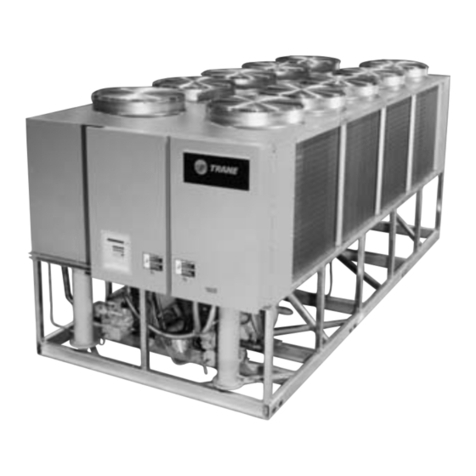
Sterlco
Sterlco Sterlco Series R RTAA-110 Installation and maintenance manual
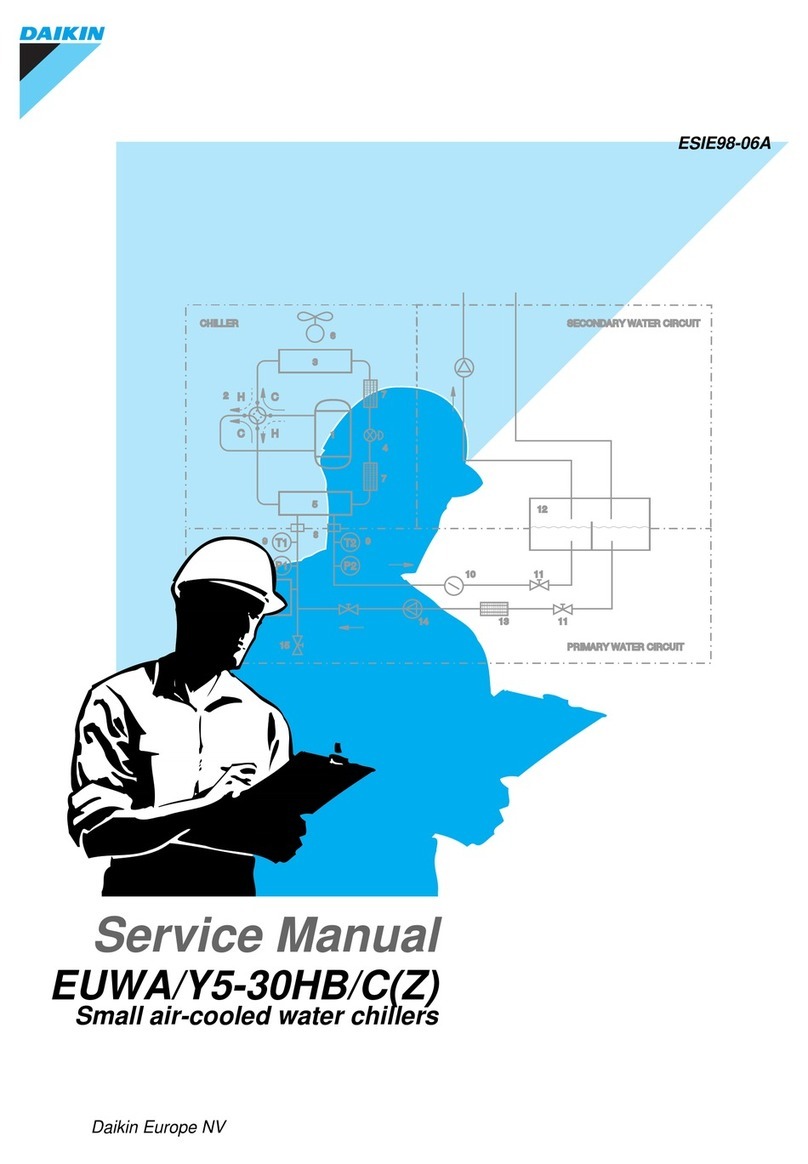
Daikin
Daikin EUWA/Y5-30HB/C(Z) Service manual
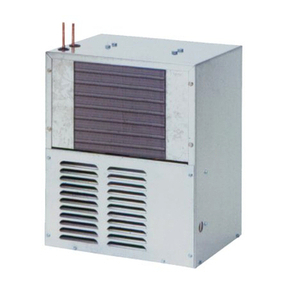
Elkay
Elkay ECH8*2H Installation, care & use manual

Carrier
Carrier AQUASNAP 30RB060-390 installation instructions
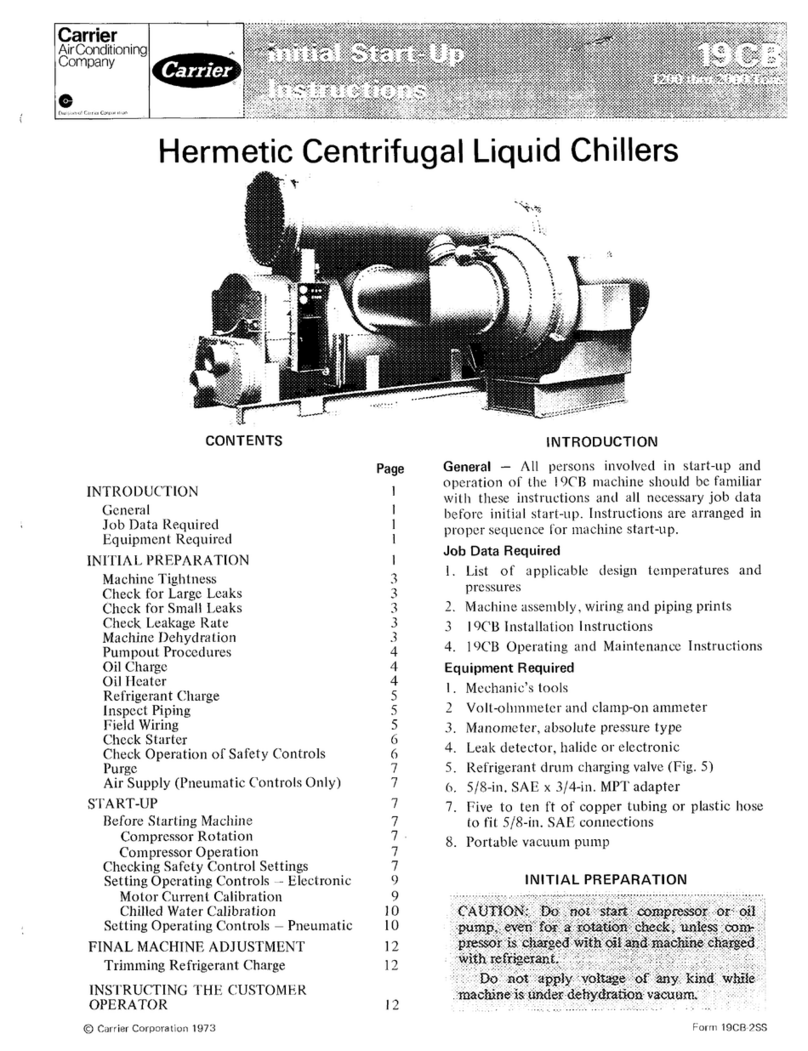
Carrier
Carrier 19CB Initial Start-Up Instructions

Castel MAC
Castel MAC T14 instruction manual
